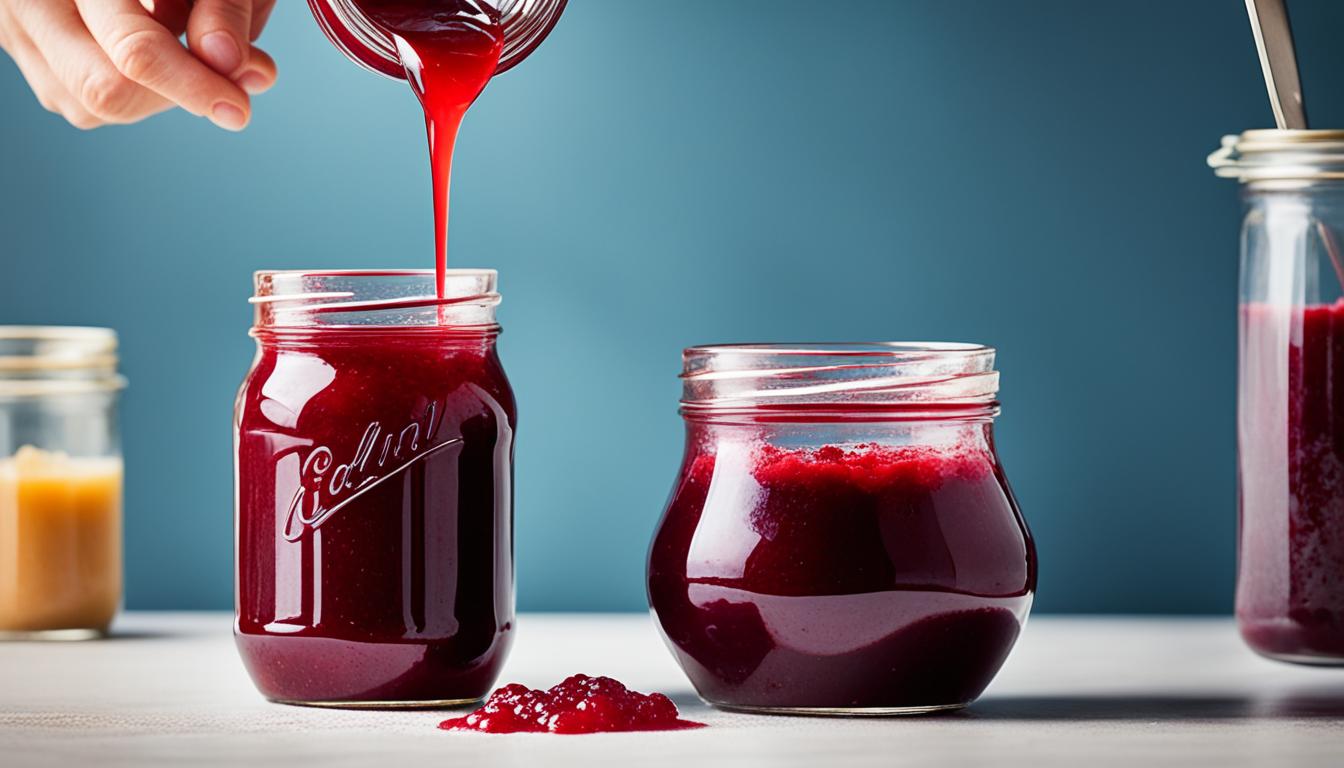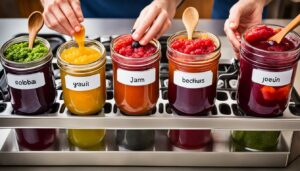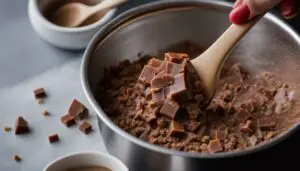Originally posted on March 26, 2024 @ 8:11 pm
Are you looking to cut back on sugar in your homemade jam recipes? Maybe you’re watching your sugar intake or simply prefer a less sweet spread. But can you actually reduce the sugar in jam recipes without compromising the final product?
Sugar serves multiple purposes in jam making, from acting as a preservative to helping achieve the desired consistency. But what happens when you lower the sugar content? Will the jam still have a long shelf life? Will it set properly? And are there alternative techniques for making low-sugar jams?
In this article, we’ll explore the possibilities of reducing sugar in jam recipes. We’ll examine the impact on shelf life, yield, and cooking time. We’ll also discuss low-sugar pectin options, storage considerations, the use of sugar substitutes, and alternative techniques for low-sugar jams. So, let’s dive in and find out if you can have your jam with less sugar!
Contents
- 1 Why Sugar is Important in Jam Making
- 2 Impact of Reducing Sugar on Shelf Life
- 3 Effects on Jam Yield and Cooking Time
- 4 Low-Sugar and Sugar-Free Pectin Options
- 5 Storage Considerations for Low-Sugar Jams
- 6 Factors Affecting the Use of Sugar Substitutes
- 7 Alternative Techniques for Low-Sugar Jams
- 8 Conclusion
- 9 FAQ
- 9.1 Can I reduce sugar in a jam recipe?
- 9.2 Why is sugar important in jam making?
- 9.3 What is the impact of reducing sugar on jam’s shelf life?
- 9.4 What are the effects on jam yield and cooking time when reducing sugar?
- 9.5 Are there low-sugar and sugar-free pectin options for making jam?
- 9.6 What are the storage considerations for low-sugar jams?
- 9.7 What factors should I consider when using sugar substitutes in jam making?
- 9.8 What are some alternative techniques for making low-sugar jams?
- 10 Source Links
Key Takeaways:
- Reducing sugar in jam recipes is possible, but it can affect shelf life, yield, and consistency.
- Sugar acts as a preservative and helps achieve the desired set in jam.
- Low-sugar pectin options and alternative techniques can be used to make homemade jams with less sugar.
- Storage considerations are important for maintaining the quality and safety of low-sugar jams.
- The use of sugar substitutes and the impact on taste and cooking properties should be carefully considered.
Why Sugar is Important in Jam Making
Sugar serves multiple purposes in jam making. It acts as a preservative, inhibiting microbial growth and preventing spoilage. The high concentration of sugar creates an unfavorable environment for mold and bacteria to develop, prolonging the shelf life of jams. In addition to its preservative properties, sugar plays a crucial role in setting the jam, giving it a desirable texture and consistency.
When heated, sugar undergoes a process known as caramelization, where it turns into a gel-like substance. This gel-like consistency, along with the natural pectin present in the fruit, helps the jam to set properly. The sugar molecules bond with the pectin molecules, forming a network that gives the jam its characteristic thickness.
Without sufficient sugar, the jam may not set properly and can end up with a runny texture. The presence of adequate amounts of sugar ensures that the jam achieves the desired consistency and forms a gel-like structure that holds its shape.
Preserving with Sugar
The preservative properties of sugar in jam making are vital in maintaining the freshness and quality of the product. High sugar concentrations in jam create an environment with reduced water activity, making it less hospitable for microorganisms to thrive. The sugar acts as a natural barrier, inhibiting the growth of mold, yeast, and bacteria.
Setting Jam with Sugar
The role of sugar in setting jam is crucial for achieving the desired texture. As the sugar is heated and dissolved, it interacts with the natural pectin present in the fruit. This interaction forms a gel-like matrix, which traps the liquid and gives the jam its characteristic thickness.
It’s important to note that different fruits contain varying amounts of natural pectin. Some fruits, like apples and citrus fruits, are naturally high in pectin, while others may require the addition of commercial pectin to help with setting. Regardless, sugar acts as a necessary partner to pectin in achieving the ideal consistency of the jam.
While the high sugar content in traditional jam recipes may not be suitable for everyone’s dietary preferences, it’s important to understand the role that sugar plays in both preservation and setting the jam. As we explore alternatives and reduce sugar in recipes, it’s essential to balance taste, texture, and safety to create delicious and satisfying homemade jams.
Impact of Reducing Sugar on Shelf Life

Reducing the amount of sugar in jam can have a significant impact on its shelf life. Sugar acts as a natural preservative, inhibiting microbial growth and preventing spoilage. When sugar is reduced in a recipe, the jam may have a decreased shelf life compared to preserves with higher sugar concentrations.
Preserves with higher sugar concentrations have longer shelf lives, as the sugar absorbs water, making it less available for the growth of mold and bacteria. This extended shelf life allows for enjoyment of the jam over a longer period.
However, if you are comfortable with a shorter shelf life and plan on consuming the jam within a relatively shorter time frame, reducing the sugar is still an option worth considering. By adjusting the sugar content, you can create a jam that aligns with your dietary preferences and still provides a delicious fruity spread.
It is important to note that when reducing sugar, alternative preservatives or storage methods may be necessary to maintain the jam’s quality. For example, keeping the jam refrigerated or using additional acid can help to inhibit microbial growth and extend the shelf life.
“Reducing the sugar content in jam can impact its shelf life, but it provides an opportunity to enjoy a homemade spread with less sugar. Consider your storage options and consumption timeframe when deciding on the sugar content of your jam.”
Overall, while the shelf life of jam may be reduced with less sugar, it is still possible to create a tasty and satisfying product. The decision ultimately depends on your personal preferences and consumption habits.
Effects on Jam Yield and Cooking Time
Reducing the amount of sugar in a jam recipe can have consequences for both the jam yield and cooking time. Sugar plays a crucial role in thickening the jam and achieving the desired set. When you choose to reduce the sugar content, it may be necessary to extend the cooking time to reach the proper concentration for setting. This prolonged cooking time can result in a reduced jam yield, as some of the moisture evaporates during the process.
Depending on the specific recipe and the amount of sugar reduction, the yield may decrease by as much as a cup or two. It’s essential to be aware of this potential decrease in yield when opting for less sugar in your jam recipes.
In addition to impacting the jam yield, the longer cooking time required for achieving proper set without added sugar can also affect the texture and flavor of the final product. It’s important to closely follow the recipe instructions and monitor the cooking process to ensure the jam reaches the desired consistency.
“Reducing the amount of sugar in a jam recipe can impact the yield and cooking time.”
Low-Sugar and Sugar-Free Pectin Options
When it comes to making low-sugar or sugar-free jams, there are pectin options available that can help you achieve delicious results without relying solely on sugar. These specialized pectins allow for lower amounts of sweeteners while still achieving a desired set. Two popular options in the market are:
- Pomona’s Pectin: This pectin brand offers a low-sugar alternative for jam making. It allows you to use less sugar or even sugar substitutes, while still achieving a gel-like consistency. With Pomona’s Pectin, you have the flexibility to create flavorful jams with reduced sugar content.
- Ball 100% Natural Reduced Calorie Fruit Pectin: Another great option for low-sugar jams is Ball’s reduced-calorie fruit pectin. With this pectin, you can create jams that have one-third less sugar compared to traditional recipes. It’s a fantastic choice for those looking to decrease their sugar intake without compromising on taste.
Both of these pectins provide alternatives to sugar in jam recipes, allowing you to enjoy homemade jams with a reduced sugar content. However, it’s important to note that they may require following specific recipes and processing instructions to achieve the best results.
Experimenting with these low-sugar pectin options can open up a world of possibilities for creating healthier jams while still preserving the delicious flavors of your favorite fruits.
Sugar Reduction Comparison:
| Pectin Brand | Sugar Reduction | Consistency | Taste |
|---|---|---|---|
| Pomona’s Pectin | Allows for lower amounts of sweeteners | Gel-like | Preserves fruit flavors well |
| Ball 100% Natural Reduced Calorie Fruit Pectin | One-third less sugar | Thick and spreadable | Similar to traditional jams |
Storage Considerations for Low-Sugar Jams

When preparing low-sugar or sugar-free jams, it is crucial to take storage considerations into account. These jams, with their reduced sugar content, may have a shorter shelf life compared to traditional high-sugar preserves. The lower sugar concentration makes them more susceptible to mold growth and spoilage.
To ensure the quality and safety of your homemade low-sugar jams, it is important to follow proper storage practices. Here are some key guidelines:
- Use low-sugar jams within a year:
- Refrigerate after opening:
- Avoid storing at room temperature:
- Check for signs of spoilage:
Unlike their high-sugar counterparts, low-sugar jams may not maintain their freshness and flavor for extended periods. It is recommended to consume them within a year of preparing them to enjoy their optimal taste.
Once opened, low-sugar jams should be stored in the refrigerator to maintain their quality. Refrigeration helps inhibit spoilage and prolongs the shelf life of the jam. Keep them in an airtight container to prevent exposure to air and moisture.
Low-sugar jams are more prone to microbial growth and mold development at room temperature. Storing them in a cool environment, such as the refrigerator, helps preserve their freshness and extends their shelf life.
Regularly inspect your low-sugar jams for signs of spoilage, such as mold growth, off-putting odors, or unusual discoloration. If you notice any such signs, discard the jam to avoid consuming spoiled preserves.
By adhering to these storage guidelines, you can enjoy your homemade low-sugar jams while ensuring their quality and safety.
Remember, proper storage plays a vital role in maintaining the freshness and taste of any homemade jam, especially those made with reduced sugar. With these storage considerations in mind, you can savor your low-sugar creations for as long as possible.
Factors Affecting the Use of Sugar Substitutes
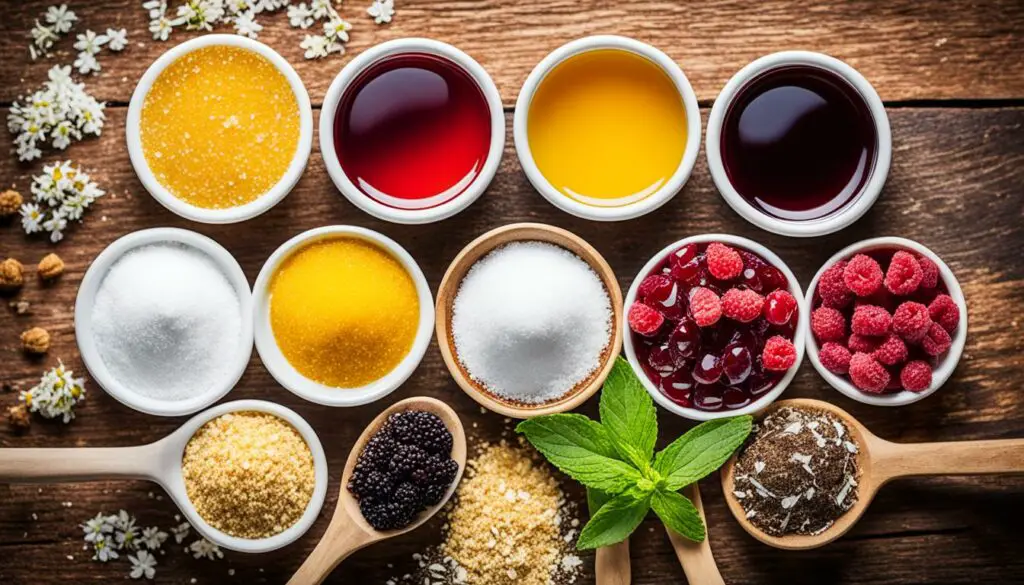
When it comes to jam making, sugar substitutes can be a viable option for those looking to reduce their sugar intake. However, it’s important to understand how these substitutes can impact both the taste and cooking properties of your homemade jams.
Different sugar substitutes have varying heat stability characteristics, which can affect their performance during the jam-making process. For example, sweeteners like aspartame may lose their sweetness when exposed to prolonged cooking, while others like acesulfame-K and saccharin are more heat-stable.
To ensure the best results when using sugar substitutes, it’s crucial to follow the manufacturer’s recommendations for each specific sweetener. These recommendations may include guidelines on the ideal cooking time and temperature for optimal results.
It’s also important to note that the absence of sugar in jams and jellies can alter the texture, flavor, and overall quality of the final product. Sugar contributes not only sweetness but also helps to enhance the natural fruit flavors and achieve the desired gel-like consistency in jams.
Experimentation is key when using sugar substitutes in jam making. It may take some trial and error to find the sweetener and combination of ingredients that best suit your taste preferences and dietary needs.
| Sugar Substitute | Taste | Cooking Properties |
|---|---|---|
| Aspartame | Tends to lose sweetness during prolonged cooking | May require shorter cooking times |
| Acesulfame-K | Heat-stable, retains sweetness during cooking | Can be used in recipes with longer cooking times |
| Saccharin | Remains sweet when exposed to heat | Suitable for recipes with extended cooking times |
Alternative Techniques for Low-Sugar Jams
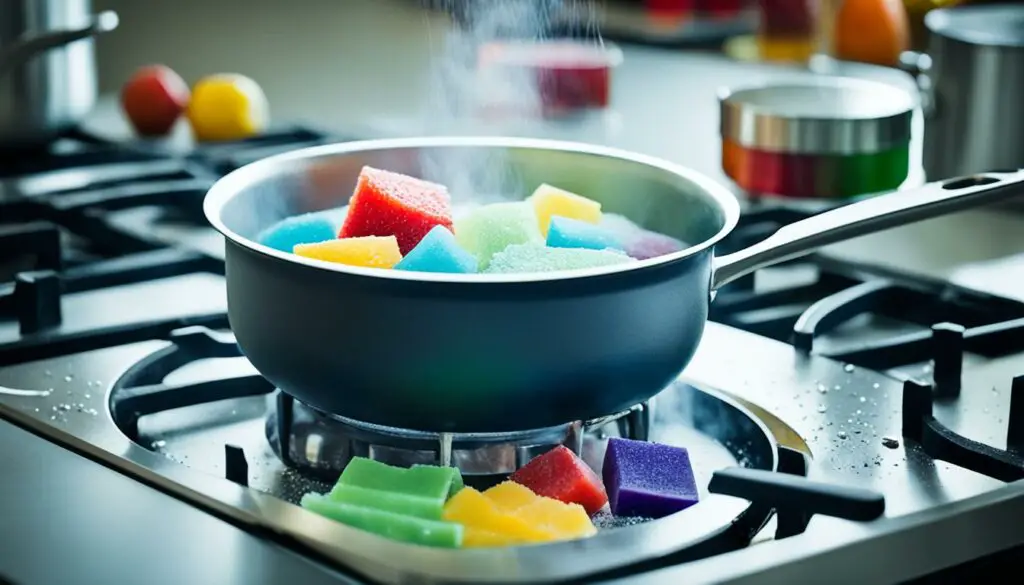
In addition to pectin-based options, there are alternative techniques you can explore to make delicious low-sugar jams. These methods offer different approaches to achieve the desired consistency and taste, allowing you to enjoy jams with reduced sugar content.
Using Gelatin as a Thickening Agent
One alternative technique is incorporating gelatin into your jam recipe. Gelatin acts as a binding agent and can help thicken the mixture, resulting in a spreadable consistency. While gelatin may not produce the same gel-like texture as traditional jams, it still delivers a delightful, sweet taste. Follow specific recipes that incorporate gelatin to ensure you achieve the desired results.
Long-Boil Methods for Reduced Sugar Jams
Another technique for creating low-sugar jams is the long-boil method. This method involves cooking the fruit for an extended period to concentrate the natural sugars and pectin. The longer cooking time helps achieve a thicker consistency without relying heavily on added sugars. It’s important to follow specific recipes and processing guidelines that outline the recommended duration for cooking fruits to reach the desired concentration.
Alternative techniques like using gelatin or opting for long-boil methods require careful attention to achieve the ideal consistency and flavor. By exploring these options, you can create delectable low-sugar jams that satisfy your taste buds while reducing the overall sugar content.
Conclusion
Reducing sugar in jam recipes is possible, but it can have various effects on the final product. By reducing sugar, you may compromise the shelf life, yield, and consistency of the jam. However, with the use of low-sugar pectin options and alternative techniques, you can still enjoy homemade jams with less sugar.
It is important to consider the trade-offs and choose the method that best suits your preferences and dietary needs. Experimentation and proper storage practices will help you find the perfect balance between reduced sugar and delicious flavor in your homemade jams.
So go ahead and explore the different options available to create jams with less sugar. Whether you choose low-sugar pectin or alternative techniques, remember to keep in mind the impact on shelf life, yield, and cooking time. With proper adjustments and careful storage, you can enjoy the benefits of reduced sugar without compromising on taste.
FAQ
Can I reduce sugar in a jam recipe?
Yes, it is possible to reduce the amount of sugar in a jam recipe. However, it may affect the shelf life, yield, and consistency of the jam.
Why is sugar important in jam making?
Sugar serves multiple purposes in jam making. It acts as a preservative by inhibiting microbial growth and helps to achieve the desired set and consistency of the jam.
What is the impact of reducing sugar on jam’s shelf life?
Reducing the sugar in a jam recipe can result in a shorter shelf life compared to traditional high-sugar preserves. Low-sugar jams are more susceptible to mold growth and spoilage.
What are the effects on jam yield and cooking time when reducing sugar?
When you reduce the sugar in a jam recipe, the cooking time may need to be extended to reach the proper concentration for set. This longer cooking time can result in a reduced yield, as some moisture evaporates during the process.
Are there low-sugar and sugar-free pectin options for making jam?
Yes, there are pectin options available specifically designed for low-sugar or sugar-free jam making. These pectins utilize different methods to achieve set without relying solely on sugar.
What are the storage considerations for low-sugar jams?
Low-sugar jams may have a shorter shelf life compared to traditional high-sugar preserves. It is recommended to use them within a year and store them in the refrigerator once opened.
What factors should I consider when using sugar substitutes in jam making?
Different sugar substitutes have different heat stability characteristics. Some may lose sweetness during prolonged cooking, while others are heat-stable. It is important to follow the manufacturer’s recommendations for each specific sweetener.
What are some alternative techniques for making low-sugar jams?
Some recipes utilize gelatin as a thickening agent, while others involve long-boil methods to concentrate natural sugars and pectin. It is important to follow specific recipes and processing guidelines for these alternative techniques.

